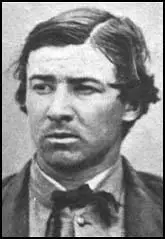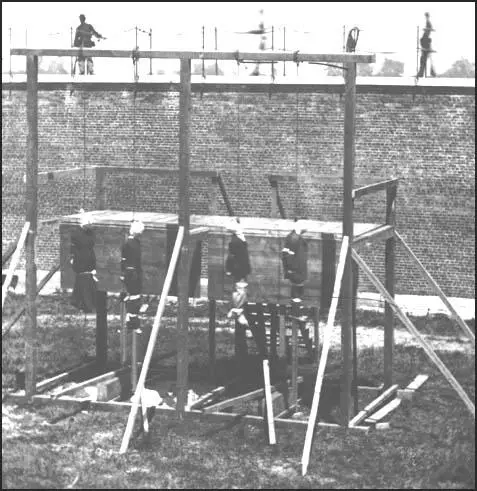David Herold

David Herold was born in Maryland on 16th June, 1842. He was the sixth of eleven children born to Mary Herold. David's father, Adam Herold was the chief clerk at the Navy Store at the Washington Navy Yard.
Herold was educated at Charlotte Hall Academy. It was here that he met John Surratt who in 1863 introduced him to his friend, John Wilkes Booth. Booth asked Herold to take part in his plot to kidnap Abraham Lincoln in Washington. The plan was to take Lincoln to Richmond and hold him until he could be exchanged for Confederate Army prisoners of war. Others involved in the plot included Lewis Powell, George Atzerodt, Michael O'Laughlin and Samuel Arnold. Booth decided to carry out the deed on 17th March, 1865 when Lincoln was planning to attend a play at the Seventh Street Hospital that was situated on the outskirts of Washington. The kidnap attempt was abandoned when Lincoln decided at the last moment to cancel his visit.
On 9th April, 1865, General Robert E. Lee surrendered to General Ulysses S. Grant at Appomattox. Two days later Booth attended a public meeting in Washington where he heard Abraham Lincoln make a speech where he explained his views that voting rights should be granted to some African Americans. Booth was furious and decided to assassinate the president before he could carry out these plans.
Booth persuaded most of the people, including Herold, who had been involved in the kidnap plot to join him in his plan. Booth discovered that on 14th April, Abraham Lincoln was planning to attend the evening performance of Our American Cousin at the Ford Theatre in Washington. Booth decided he would assassinate Lincoln while George Atzerodt would kill Vice President Andrew Johnson and Powell agreed to murder William Seward, the Secretary of State. All attacks would take place at approximately 10.15 p.m. that night.
At 10.00 p.m. Herold and Lewis Powell arrived at the home of William Seward, who was recovering from a serious carriage accident. When William Bell, a servant opened the door, Powell told him he had medicine from Dr. Tullio Verdi. When Bell refused to let him in, Powell pushed past him and rushed up the stairs. Frederick Seward, the Secretary of State's son, came out and asked him what he wanted. Powell hit Steward with his revolver so hard he fracturing his skull in two places. Powell was now confronted with George Robinson, Seward's bodyguard. Powell slashed him with his bowie knife before leaping onto Seward's bed and repeatedly stabbed him. Powell, thinking he had killed him, racing out of the house where Herold was waiting with his horse.
Herold went to Mary Surratt's boarding house and together with John Wilkes Booth, who had successfully killed Abraham Lincoln, headed for the Deep South.
At 4.00 a.m. Herold and John Wilkes Booth arrived at the home of Dr. Samuel Mudd who treated Booth's broken leg. With the help of other sympathizers they reached Port Royal, Virginia, on the morning of 26th April. They hid in a barn owned by Richard Garrett. However, federal troops arrived soon afterwards and the men were ordered to surrender. Herold came out of the barn but Booth refused and so the barn was set on fire. While this was happening one of the soldiers, Sergeant Boston Corbett, found a gap in the barn and shot Booth. His body was dragged from the barn and after being searched the soldiers recovered his diary.
On 1st May, 1865, President Andrew Johnson ordered the formation of a nine-man military commission to try the conspirators. It was argued by Edwin M. Stanton, the Secretary of War, that the men should be tried by a military court as Lincoln had been Commander in Chief of the army. Several members of the cabinet, including Gideon Welles (Secretary of the Navy), Edward Bates (Attorney General), Orville H. Browning (Secretary of the Interior), and Henry McCulloch (Secretary of the Treasury), disapproved, preferring a civil trial. However, James Speed, the Attorney General, agreed with Stanton and therefore the defendants did not enjoy the advantages of a jury trial.
The trial began on 10th May, 1865. The military commission included leading generals such as David Hunter, Lewis Wallace, Thomas Harris and Alvin Howe and Joseph Holt was the government's chief prosecutor. Mary Surratt, Lewis Powell, George Atzerodt, David Herold, Samuel Mudd, Michael O'Laughlin, Edman Spangler and Samuel Arnold were all charged with conspiring to murder Lincoln. During the trial Holt attempted to persuade the military commission that Jefferson Davis and the Confederate government had been involved in conspiracy.
Joseph Holt attempted to obscure the fact that there were two plots: the first to kidnap and the second to assassinate. It was important for the prosecution not to reveal the existence of a diary taken from the body of John Wilkes Booth. The diary made it clear that the assassination plan dated from 14th April. The defence surprisingly did not call for Booth's diary to be produced in court.
Herold's lawyer, Frederick Stone, called several witnesses to show that his client did not hold strong political opinions. He also claimed that Herold had the mentality of an 11 year old and was not responsible for his actions.
On 29th June, 1865, Herold, Lewis Powell, Mary Surratt, George Atzerodt, David Herold, Samuel Mudd, Michael O'Laughlin, Edman Spangler and Samuel Arnold were found guilty of being involved in the conspiracy to murder Abraham Lincoln. Herold, Powell, Surratt and Atzerodt were hanged at Washington Penitentiary on 7th July, 1865.

George Atzerodt at Washington Penitentiary on 7th July, 1865.
Primary Sources
(1) Otto Eisenchiml, Why Was Lincoln Murdered? (1937)
Another bizarre feature in the story of Booth's pursuit is the failure of the War Department to prosecute some people who had sheltered Booth and helped him in his flight. Again, the House of Representatives Committee, debating the distribution of rewards, was puzzled. In a proclamation dated 20 April, Stanton had declared that "All persons harboring or secreting the conspirators or aiding their concealment or escape, will be treated as accomplices in the murder of the President and shall be subject to trial before a military commission, and the punishment of death.
(2) Ben Pittman, The Assassination of President Lincoln and the Trial of the Conspirators (1865)
Herold is a doltish, insignificant-looking man with a slender frame and irresolute, cowardly appearance.
(3) Captain Christian Rath, was placed in charge of the execution of Mary Surratt, Lewis Powell, George Atzerodt, David Herold, Michael O'Laughlin, Edman Spangler and Samuel Arnold. He was later interviewed about his role in the event.
I was determined to get rope that would not break, for you know when a rope breaks at a hanging there is a time-worn maxim that the person intended to be hanged was innocent. The night before the execution I took the rope to my room and there made the nooses. I preserved the piece of rope intended for Mrs. Surratt for the last.
I had the graves for the four persons dug just beyond the scaffolding. I found some difficulty in having the work done, as the arsenal attaches were superstitious. I finally succeeded in getting soldiers to dig the holes but they were only three feet deep.
The hanging gave me a lot of trouble. I had read somewhere that when a person was hanged his tongue would protrude from his mouth. I did not want to see four tongues sticking out before me, so I went to the storehouse, got a new white shelter tent and made four hoods out of it. I tore strips of the tent to bind the legs of the victims.
(4) William Coxshall, a member of the Veteran Reserve Corps, was assigned the task of dropping the trapdoor on the left side of the gallows.
The prison door opened and the condemned came in. Mrs. Surratt was first, near fainting after a look at the gallows. She would have fallen had they not supported her. Herold was next. The young man was frightened to death. He trembled and shook and seemed on the verge of fainting. Atzerodt shuffled along in carpet slippers, a long white nightcap on his head. Under different circumstances, he would have been ridiculous.
With the exception of Powell, all were on the verge of collapse. They had to pass the open graves to reach the gallows steps and could gaze down into the shallow holes and even touch the crude pine boxes that were to receive them. Powell was as stolid as if he were a spectator instead of a principal. Herold wore a black hat until he reached the gallows. Powell was bareheaded, but he reached out and took a straw hat off the head of an officer. He wore it until they put the black bag on him. The condemned were led to the chairs and Captain Rath seated them. Mrs. Surratt and Powell were on our drop, Herold and Atzerodt on the other.
Umbrellas were raised above the woman and Hartranft, who read the warrants and findings. Then the clergy took over talking what seemed to me interminably. The strain was getting worse. I became nauseated, what with the heat and the waiting, and taking hold of the supporting post, I hung on and vomited. I felt a little better after that, but not too good.
Powell stood forward at the very front of the droop. Mrs. Surratt was barely past the break, as were the other two. Rath came down the steps and gave the signal. Mrs. Surratt shot down and I believed died instantly. Powell was a strong brute and died hard. It was enough to see these two without looking at the others, but they told us both died quickly.

